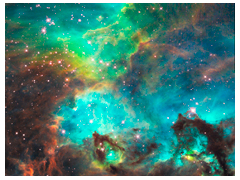 Copyright(c)www.hubblesite.org All Rights Reserved.
Copyright(c)www.hubblesite.org All Rights Reserved.
The star cluster NGC 2074 and peripheral nebulas in the Large Magellanic Cloud, a satellite of our Milky Way galaxy. The region lies about 170,000 light-years away in the constellation Dorado or the Sword-fish, and is invisible from Japan. This snapshot was made by the Hubble Space Telescope on 10 August 2008, one day before the Telescope completed 100,000 orbits since first being sent into space at 7:42 AM, August 11, 2008 U.S. Eastern time (8:42 PM Japan time).
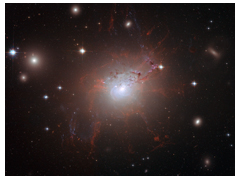 Copyright(c)www.hubblesite.org All Rights Reserved.
Copyright(c)www.hubblesite.org All Rights Reserved.Snapshot of the active galaxy NGC 1275, which lies over 230 million light years away in the constellation Perseus, as taken by the Hubble Space Telescope. This is an elliptical galaxy located in the center of the Perseus cluster of galaxies. The long thread-like filaments of light that stretch out into the surrounding galaxy cluster are given off by gas trapped in the strong magnetic field created from the supermassive black hole hosted by NGC 1275. This galaxy also gives off strong electric waves.
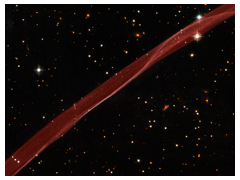 Copyright(c)www.hubblesite.org All Rights Reserved.
Copyright(c)www.hubblesite.org All Rights Reserved.This snapshot, taken by the Hubble Space Telescope, shows a delicate ribbon of gas in space. It is a very thin section of a remnant of the supernova SN1006, which first appeared in the constellation Lupus in 1006 A.D. Seen from the earth now, the remnant looks round and of the same diameter as the full moon, but in actuality it has a diameter of nearly 60 light-years.
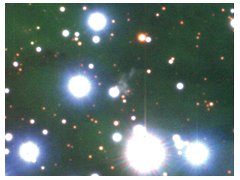 Copyright(c)www.subarutelescope.org All Rights Reserved.
Copyright(c)www.subarutelescope.org All Rights Reserved.This snapshot, taken by the Subaru telescope, shows the supernova remnant Cassiopeia A (Cas A). Contemporary astronomers, through observations of the "light echo" of Cas A, have concluded that the initial supernova explosion occurred in the late 17th century. From analysis of the "light echo" shown here astronomers now surmise that the progenitor of Cas A was a red super giant that experienced an explosive outburst of Type IIb.
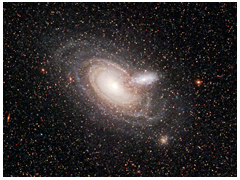 Copyright(c)www.hubblesite.org All Rights Reserved.
Copyright(c)www.hubblesite.org All Rights Reserved.The Sculptor Galaxy in the constellation Sculptor, as captured by the Hubble Space Telescope. A rare alignment between two spiral galaxies, one in the foreground and one in the background. The background galaxy is 780 million light-years away from us, while the distance of the galaxy in the foreground is still unknown, although obviously closer to Earth. The fixed stars speckled across the image belong to the nearby spiral galaxy NGC 253, which is beyond view to the right.
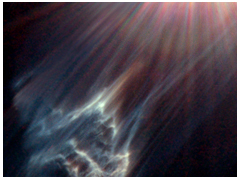 Copyright(c)www.hubblesite.org All Rights Reserved.
Copyright(c)www.hubblesite.org All Rights Reserved.This photograph is the Merope Nebula in the Pleiades star cluster, as captured by the Hubble Space Telescope. The Merope Nebula, whose brightness is 4th magnitude, is just outside the frame on the upper right. The colorful rays of light are an optical phenomenon produced by the light of stars within the telescope, and are not real. But the remarkable parallel wisps extending from lower left to upper right are real features, streams of dust particles.
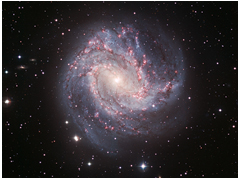 Copyright(c)www.eso.org All Rights Reserved.
Copyright(c)www.eso.org All Rights Reserved.The spiral galaxy Messier 83
This photograph is the spiral galaxy Messier 83, as captured by ESO/MPG 2.2-m telescope of the European Southern Observatory. Messier 83 lies roughly 15 million light-years away from us. Massive stars were born at the spiral arms of Messier 83 and the ultraviolet radiation is causing huge regions of hydrogen to glow red. The light is shining like billions of rubies scattered across space.
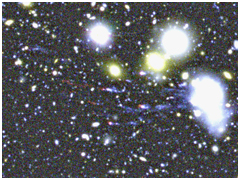 Copyright(c)www.subarutelescope.org All Rights Reserved.
Copyright(c)www.subarutelescope.org All Rights Reserved.This snapshot, taken by the Subaru telescope, shows the bright knots of fireballs in the Coma Berenices galaxy clusters. Several red "fireballs" of ionized gas with blue filaments look like projectiles flying straight out to the left from Galaxy RB199, which is at the right edge. The size of the "fireballs" structure, including the pale gas cloud, is about 260 thousand light years, a size large enough to enclose our galaxy.
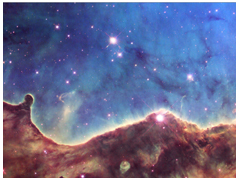 Copyright(c)www.hubblesite.org All Rights Reserved.
Copyright(c)www.hubblesite.org All Rights Reserved.The landscape of the star-forming region, taken by the Hubble Space Telescope.
This is a photograph of the star-forming region NGC 3324 in the Carina Nebula as captured by Hubble Space Telescope. There are newly-born young stars in the upper side of the image. Strong ultraviolet radiation and stellar winds are blazing out from the stars and eroding the cold, dark nebula at the bottom of the image. This cosmic landscape is located roughly 7,200 light-years from the earth.
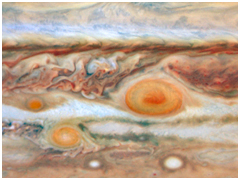 Copyright(c)www.hubblesite.org All Rights Reserved.
Copyright(c)www.hubblesite.org All Rights Reserved.This snapshot, taken by the Hubble Space Telescope in May 2008, shows the Great Red Spot of Jupiter. There are a small spot and a spot of middling size near the Great Red Spot, which have come to be called, respectively, "the third red spot" and "Red Spot Jr". In July it was observed that the smallest oval was absorbed by the Great Red Spot. The mysterious Great Red Spot has existed for at least several hundred years. It is a huge swirl of high atmospheric pressure big enough to contain two earths.
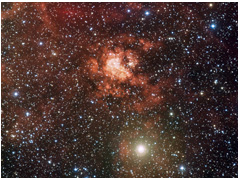 Copyright(c)www.eso.org All Rights Reserved.
Copyright(c)www.eso.org All Rights Reserved.This image, captured from Chile by the Wide Field Imager (WFI) camera attached to the 2.2-m Max-Planck/ESO (European Organisation for Astronomical Research in the Southern Hemisphere) telescope shows the vast stellar nursery Gum 29. At its centre shines the cluster of young stars Westerlund 2 which were newly born one or two million years ago.
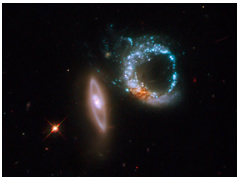 Copyright(c)www.hubblesite.org All Rights Reserved.
Copyright(c)www.hubblesite.org All Rights Reserved.A pair of galaxies which look like the number 10.
This photograph is of a pair of peculiar galaxies called Arp 147, as captured by the Hubble Space Telescope in October 2008. The two galaxies lie roughly 440 million light-years away in the direction of Cetus, and their shapes look strange because they are interacting gravitationally. They happen to be oriented so that they look just like the number "10." The galaxy that looks like a one is not so active, but the galaxy that looks a zero exhibits a clumpy, blue ring of intense star formation.
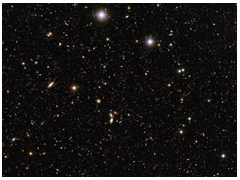 Copyright(c)www.eso.org All Rights Reserved.
Copyright(c)www.eso.org All Rights Reserved.The sea of galaxies
This photograph is of deep space, as captured by the 8-meter Very Large Telescope (VLT) of the European Southern Observatory in Chile. The image combines data obtained with the Wide-Field Imager (WFI) attached to the 2.2 meter MPG/ESO telescope. It is the result of 55 hours of observations and it is the deepest ground-based image of the Universe ever obtained. Galaxies of diverse colors and sizes are seen in this image.
 Copyright(c)www.hubblesite.org All Rights Reserved.
Copyright(c)www.hubblesite.org All Rights Reserved.This image taken by NASA's Hubble Space Telescope showcases the brilliant core of the galaxy called NGC1569, which is located roughly 11 million light-years away from Earth, in the direction of Camelopardalis. In this area, young stars are very actively and newly formed. NGC 1569 is pumping out stars at a rate that is 100 times faster than the rate observed in our Milky Way Galaxy. What shines in red is the ionized gas radiated by the ultraviolet rays of stars newly born.
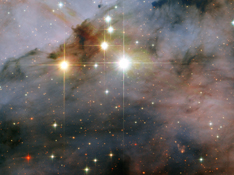 Copyright(c)www.hubblesite.org All Rights Reserved.
Copyright(c)www.hubblesite.org All Rights Reserved.The image as captured by the Hubble Space Telescope shows the bright glow of a pair of colossal stars that lie approximately 7500 light-years from Earth in the constellation of Carina, the Keel. WR 25 in particular, situated near the center of the image, is a huge star thought to be 50 times the size of the sun. It is one of the biggest stars in our Milky Way. The light and wind from these stars is in process of blowing away the nebula surrounding them.
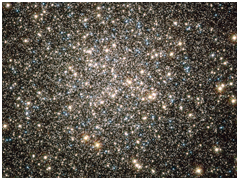 Copyright(c)www.hubblesite.org All Rights Reserved.
Copyright(c)www.hubblesite.org All Rights Reserved.The image as captured by the Hubble Space Telescope shows the center part of the globular cluster M13 in the constellation Hercules, which is located roughly 25,000 light years away. It is the brightest and biggest globular cluster in the northern sky, and popular among astronomy fans. Here and there young-looking blue straggler stars are visible shining bluely among the many old stars.
 Copyright(c)X-ray: NASA/CXC/CfA/S.Wolk et al; IR: NASA/JPL-Caltech
Copyright(c)X-ray: NASA/CXC/CfA/S.Wolk et al; IR: NASA/JPL-CaltechThe image as captured by the Chandra X-ray Telescope and Spitzer Infrared Space Telescope shows RCW 108, which is a region where stars are actively forming within the constellation Ara. This is a region which lies about 4,000 light years from Earth and which is deeply embedded in a cloud of molecular hydrogen. X-ray and infrared make young star clusters inside the clouds shine.
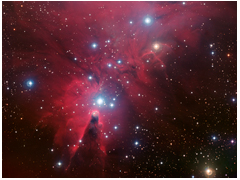 Copyright(c)www.eso.org All Rights Reserved.
Copyright(c)www.eso.org All Rights Reserved.This image, captured from Chile by the Wide Field Imager (WFI) camera attached to the 2.2-m Max-Planck/ESO (European Organisation for Astronomical Research in the Southern Hemisphere) telescope, shows the region known as NGC 2264. The nebula lies roughly 2600 light-years away in the direction of Monoceros. This area of the sky includes newly born young stars which shine in blue. The trianglular dark nebula seen at the bottom of the image is well known for being shaped like a Christmas tree.
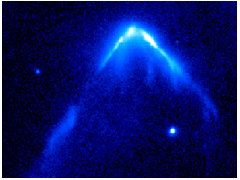 Copyright(c)www.hubblesite.org All Rights Reserved.
Copyright(c)www.hubblesite.org All Rights Reserved.Young, runaway stars and gas as captured by the Hubble Space Telescope.
This photograph taken by the Hubble Space Telescope shows stars plowing through regions of dense interstellar gas at high speed. You can tell that the surrounding dense gas makes ripples shaped like a strung bow, just like the pattern made when a boat moves across a lake. They are created by the interaction between powerful stellar winds and interstellar gas.
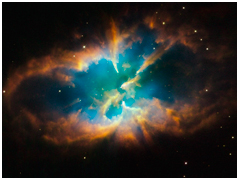 Copyright(c)www.hubblesite.org All Rights Reserved.
Copyright(c)www.hubblesite.org All Rights Reserved.A planetary nebula captured by the Hubble Space Telescope
This photograph taken by the Hubble Space Telescope shows the planetary nebula NGC 2818, which is nestled inside the open star cluster NGC 2818A, over 10,000 light-years away in the southern constellation Pyxis (the Compass). A star as big as the Sun has reached the last phase of its life and the core of the star, which will become a white dwarf, illuminates the exterior gases that have parted from it. Red represents nitrogen, green represents hydrogen, and blue represents oxygen.
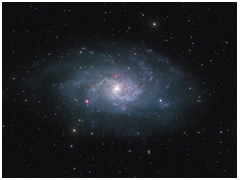 Copyright(c)www.subarutelescope.org All Rights Reserved.
Copyright(c)www.subarutelescope.org All Rights Reserved.Galaxy M33 in Triangulum captured by the Subaru Telescope
The spiral galaxy M33, also known as the Triangulum Galaxy, belongs to the local galactic group which contains our Milky Way Galaxy and the Andromeda Galaxy is the second biggest spiral galaxy after our Milky Way Galaxy. There is roughly 2.5 million light-years between them. They almost completely face each other, which makes it possible for us to examine the structure of the spiral galaxy. By making the most of the wide field technology which is its strong point, the Subaru Telescope has captured a detailed image which corresponds in size to eight times the width of the full moon, or 90,000 light-years by 60,000 light-years. This is the first time an image has been captured at this high quality resolution and depth.
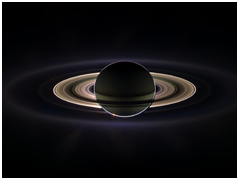 Copyright(c) NASA/JPL/Space Science Institute All Rights Reserved.
Copyright(c) NASA/JPL/Space Science Institute All Rights Reserved.Saturn against the background of the sun as captured by the Cassini probe
This image was taken by the Cassini probe, which is circulating around Saturn while observing the planet, its rings and satellites.On Sept. 15, 2006, Cassini drifted to the back of the Saturn and took this image while cutting off the light from the sun.This image, which was created by superimposing ultraviolet, infrared and clear filter images, clearly shows even the faint rings of Saturn.
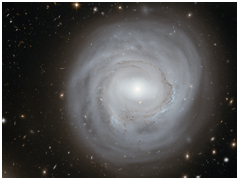 Copyright(c) NASA, ESA and K. Cook (Lawrence Livermore National Laboratory, USA). All Rights Reserved.
Copyright(c) NASA, ESA and K. Cook (Lawrence Livermore National Laboratory, USA). All Rights Reserved.The spiral galaxy and remote galaxies captured by the Hubble Space Telescope.
This photograph taken by the Hubble Space Telescope shows the spiral galaxy NGC 4921, which belongs to the constellation Coma Berenices and is located about 320 million light-years from Earth. The image also shows NGC 4921's background of remote galaxies of many colors and shapes stretching back to the early Universe.
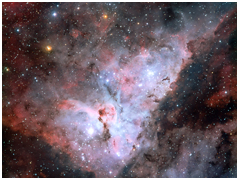 Copyright(c)www.eso.org All Rights Reserved.
Copyright(c)www.eso.org All Rights Reserved.
The Carina Nebula captured by the Telescope of the European Southern Observatory.
This photograph is of the Carina Nebula in the constellation of Carina which lies 7500 light-years from Earth, as captured by the Wide Field Imager attached to the 2.2-meter telescope of the European Southern Observatory in Chile. From monster stars like Eta Carinae, which is over 100 times the mass of our sun, gases and ultraviolet rays spurt out. This makes the nebula, which spans about 100 light-years, glow in a complex of colors.
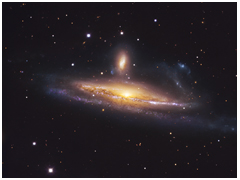 Copyright(c)www.eso.org All Rights Reserved.
Copyright(c)www.eso.org All Rights Reserved.
Galactic waltz captured by the Telescope of the European Southern Observatory.
This photograph shows the galaxy pair NGC 1531/2 which is located about 70 million light-years away, as captured by the 1.5-metre telescope at the European Southern Observatory in Chile. These galaxies are located in the southern constellation Eridanus. The warped spiral arms, which are lifted from the disk, show that the two galaxies are approaching each other and moving in response, just as if dancing.
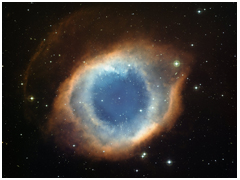 Copyright(c)www.eso.org All Rights Reserved.
Copyright(c)www.eso.org All Rights Reserved.
The Carina Nebula as captured by the Telescope of the European Southern Observatory
This photograph is of the Helix Nebula, which is 700 light-years from Earth in the constellation of Aquarius, as captured by the Wide Field Imager attached to the 2.2-meter telescope of the European Southern Observatory in Chile. It is a planetary nebula, formed when the outer material of an old fixed star is expelled into space and the clouds of expelled gas shine brightly in the intense ultraviolet radiation of the white dwarf star at the core. Because of its relative proximity to Earth, the Helix Nebula occupies a portion of the sky roughly a quarter of the size of the full Moon.
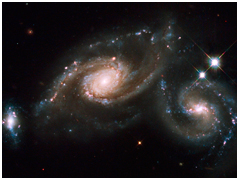 Copyright(c)www.hubblesite.org All Rights Reserved.
Copyright(c)www.hubblesite.org All Rights Reserved.A group of three galaxies as taken by the Hubble Space Telescope.
To commemorate the International Year of Astronomy (IYA), the Hubble Space Telescope photographed the winning target in the Space Telescope Science Institute's "You Decide" competition. The winner is a mysterious group of three galaxies called Arp 274. The entire system resides about 400 million light-years away from Earth in the constellation Virgo.


